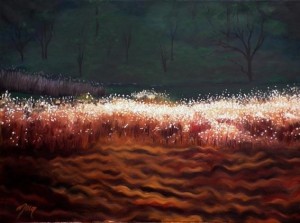
But Rod’s role in the project doesn’t end there as he is also exploring how the local sugar industry was represented in the works of such artists as Sir Stanley Spencer and Joan Eardley. These two artists recorded the local shipbuilding industry in their works, an industry that no exists except in the remnants of the Sugar Sheds at James Watt Dock and the Glebe refinery building. Rod is therefore talking to the community, gleaming stories and memories from the people about the sugar trade and it’s impact to inspire his paintings. So he is always on the look out for more people to talk to. So please just get in touch if you have anything to share about both the sugar and shipbuilding industries. Thank you.

Through talking to Rod I came to realise there is much more to his artist practice than just research, compose and paint. As Rod said himself, “Painting is non of your leisurely relaxing airy fairy routine. It’s hard work and graft and feeling.”
Painting is a solo effort and is pretty intense. First, he works things out in his head, often going from ideas straight to canvas. Sometimes he might work about with the composition on paper and draw some of the parts out with pencils and charcoal but these always seem to change a bit when he starts to paint in oils.

When Rod gets into the painting itself more often that not things start to change again. It will end up looking quite different from what he had in his head when he started out. But that’s just the creative process, the part where the painting is creating itself. It take’s on it’s own life force and energy and dictates to the artist how it wants to look.
Rod mentions a struggle at this point between him and the painting. Between how he wants the painting to look and how the painting itself wants to be seen. In the end the painting always wins.
I found it fascinating talking to Rod about his artist’s process and the energy that exudes from the final art works. Thank you for sharing Rod, it was a pleasure.
